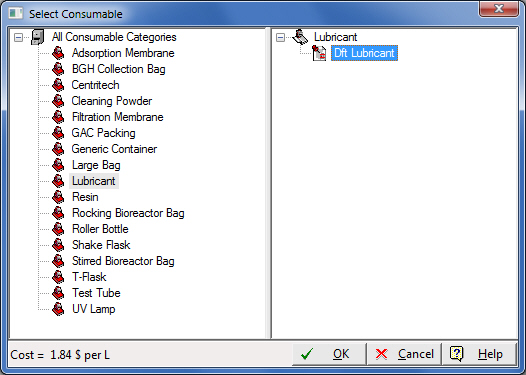

This tab is part of the Equipment Data dialog (common to all equipment types). The dialog can be viewed when selecting the Equipment Data menu option from a unit procedure’s command menu.
From this tab the user can associate the consumption of a (non-required) consumable to the operation of the equipment. Sometimes, the cost of such consumables may be a significant percentage of the overall running cost of an equipment resource, and it should not be ignored. Cleaning powder, lubricants etc. may be an important expense that can affect the overall operating cost. Each line of the table, if present, represents the utilization of a consumable.
► To Add a New Consumable Use
1. Click on the ‘Add New’ button above the table ( ) and select a consumable.
) and select a consumable.
2. Type in the consumption rate
3. Type in the replacement frequency rate
Then a dialog similar to the following appears (actual contents may be different in your installation):

After selecting a specific consumable, a new line is entered in the table. The field “Quantity Measuring Units” is non-editable and specifies in what units the selected consumable’s amount is supposed to be measures (e.g. for a lubricant it may be Liters, for a cartridge it may be items, etc.) These units are part of the consumable definition (see Consumables Databank) and cannot be changed from this dialog.
The key variable that you need to specify for each consumable use, is the Consumption Rate. This value is supposed to guide the application in calculating how much of the consumable is spent in the span of a batch or a campaign or a year. The rate is typically reported as amount of consumable per some reference quantity related to the size of the equipment resource: it could be a direct measure of the size (in volume units like L, gal, etc.) or it could simply be per unit of equipment. The equipment size units depend on the type of equipment resource that is being edited: if the equipment type has a volume representing its size (e.g. vessels) then the size units displayed would be of volume (e.g. m3, L, gal, etc.). If the equipment type has an area representing its size (e.g. a filter) then the units will be of area (e.g. m2, in2 etc.). Of course, number of items or number of units will always be an option for specifying a rate that is per piece of equipment (and per use).
Finally, the last information that you need to enter (per consumable use) is the replacement frequency. This can be provided on either per hour of use basis, or on a per cycle of use basis.
After the M&E balances are executed, the application will report in the Total Amount (per use) column the calculated amount of consumable that is utilized by the equipment (per use). This value, in conjunction with the replacement rate will be used to calculate the contribution of this consumable to the annual operating cost.
Sometimes the equipment hosts a procedure that, due to its nature, may not make use of the consumable, and therefore it should be excluded from the tallying of the total consumption. For example, sometimes it is convenient to have dedicated wash/regeneration procedures for chromatography columns that may be repeated either at the beginning or the end of a multi-cycle chromatography step. To represent such an event, a separate, single-cycle procedure must be set up, hosted by the same column, and the necessary wash/regeneration steps are added and times to execute appropriately. Users may elect to exclude this type of use of the column’s raisin from counting to its total life before replacement. This accomplished by using the control at the bottom of the tab. If the procedure is the single-user of the equipment then a check-box (as shown in the picture above appears). If there are several users of the equipment resource, then instead of the check-box a button like:

will appear. Clicking on the button, will present the list of procedures that can be excluded from having the equipment’s consumable counted.